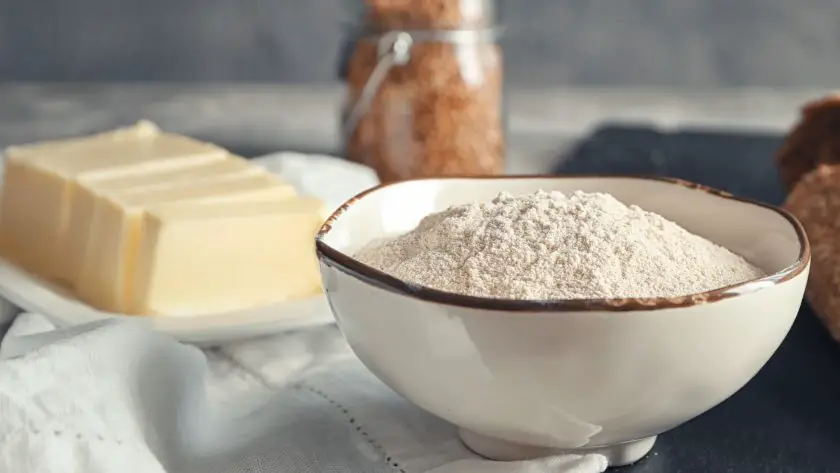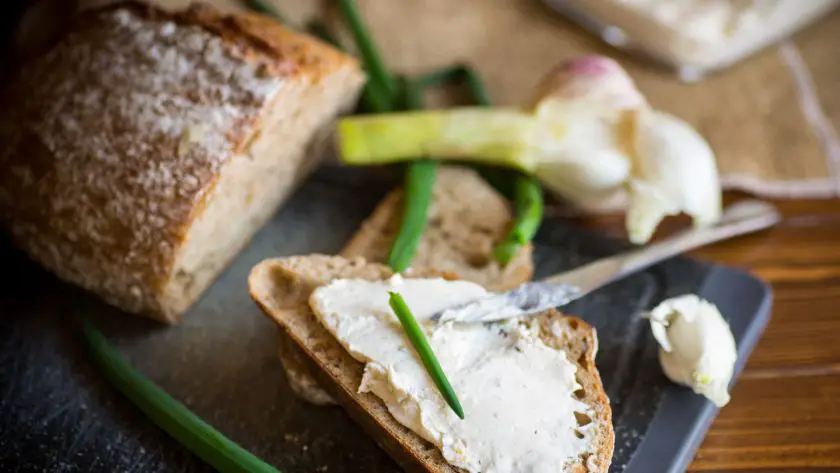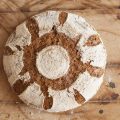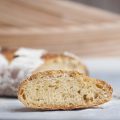For those who love sourdough but struggle with digesting bread, the concept of a gut-friendly artisan loaf seems too good to be true. Yet with careful selection of non-inflammatory grains and proper long fermentation, low FODMAP sourdough offers that satisfying chewy crumb without wreaking havoc on your stomach. Yes, you can enjoy tasty high-quality loaves that your body appreciates too. Read on to find out how to make your own sourdough bread that’s low FODMAp!

Table of Contents
- What is Low FODMAP Sourdough?
- Benefits of Low FODMAP Sourdough Bread
- How to Know Your Sourdough is Low FODMAP
- Making Low FODMAP Sourdough Bread at Home
- Common Mistakes and Tips
- Pairing and Serving Suggestions
- Substitutes for Low FODMAP Sourdough
- Delicious and Digestible
- FAQs

Low FODMAP Sourdough Bread Recipe
Making your own gut-friendly sourdough at home ensures you can enjoy all the qualities of artisan bread without the unpleasant side effects. With some patience and practice, anyone can create an IBS-friendly sourdough loaf.
- Total Time: 50 minutes
- Yield: 1 loaf (12 slices) 1x
Ingredients
Sourdough Starter
- 1 cup Buckwheat Flour (for initial mix) + 1 cup (for feeding)
- 1 cup Warm Filtered Water (for initial mix) + ¾ cup (for feeding)
Dough
- 3 cups Gluten-Free Flour Blend
- 1 tsp Sea Salt
- 1 cup Sourdough Starter
- 1½ cups Warm Water
Instructions
Starter
- Mix 1 cup buckwheat flour with 1 cup warm filtered water.
- Cover and let sit at room temp for 48 hours, stirring occasionally, until bubbly and pungent.
- Discard half, add 1 cup flour and 3⁄4 cup water, stir, cover, and ferment 24 hours to build starter strength.
Making the Bread
- For the dough, whisk 3 cups gluten-free flour blend, 1 tsp sea salt, 1 cup starter and 11⁄2 cups warm water.
- Knead lightly to combine then cover and proof 16-24 hours at room temp until doubled in bulk.
- Punch down and shape into a round loaf. Let rise 2 more hours.
- Slash an X across the top of your risen loaf and set it on parchment paper on a baking sheet.
- Bake at 425°F for 45-50 minutes, rotating once, until deep brown. The internal temperature should register 208°F.
- Let cool completely on a wire rack before slicing to maintain texture.
- Store leftover sourdough bread cut-side down on the countertop in a breadbox or paper bag for up to 3 days.
Notes
- Enjoy it toasted or untoasted in sandwiches, with soups and stews, or dipped in olive oil!
- Cook Time: 50 mins
- Category: bread
Nutrition
- Serving Size: 1 slice
- Calories: 200
- Sodium: 200 mg
- Carbohydrates: 40 g
- Fiber: 4 g
- Protein: 5 g
What is Low FODMAP Sourdough?
Low FODMAP sourdough bread is a type of artisan bread made with a long fermentation sourdough starter that makes it easier to digest, especially for those with IBS or sensitive stomachs. The ingredients and process used to make low FODMAP sourdough bread differ from regular bread in order to create a gut-friendly loaf that can be enjoyed without gastrointestinal discomfort.
Ingredients
Low FODMAP sourdough bread is made without common allergens like wheat, rye, and barley. Instead, the flour used is usually a gluten-free variety made from grains like rice, buckwheat, quinoa, or almond.
The sourdough starter contains live active cultures that help break down and ferment FODMAP carbohydrates during the long proofing time. Using tap water instead of bread improver also keeps FODMAP levels low.
- ALMOND FLOUR, also called almond meal or almond powder, is naturally GLUTEN FREE, made from 100% all-natural blanched almonds.
- Almond flour is a gluten free, grain free, low carb, SINGLE INGREDIENT, all natural, non-GMO, kosher, vegan, KETO friendly and PALEO friendly flour.
- Almond flour is made from FINELY GROUND blanched almonds. Blanching is the process of removing the outer skin of the almond. This makes a whiter, TASTIER super FINE TEXTURED flour.
- Almond flour is a great wheat flour alternative. Adding almond flour to your homemade cooked and baked goods will give them a SWEET taste, MOIST texture and rich nutty, buttery FLAVOR.
- Almond flour is a perfect choice for keto and paleo diets. Almond flour is very LOW IN CARBS and full of good fat and other HEALTHY NUTRIENTS. Use almond flour in your bread, muffins, pancakes and any other favorite reci
Prices pulled from the Amazon Product Advertising API on:
Product prices and availability are accurate as of the date/time indicated and are subject to change. Any price and availability information displayed on [relevant Amazon Site(s), as applicable] at the time of purchase will apply to the purchase of this product.
Baking Process
Allowing the dough to slowly ferment for 16-24 hours helps reduce the FODMAP content while enhancing flavor. The live cultures in the starter digest the carbohydrates into forms that don’t ferment in the digestive system or cause uncomfortable gas and bloating.
This long proof time (even longer compared to the traditional sourdough bread process) is the secret behind creating an IBS-friendly artisan bread.
Resulting Characteristics
When done right, low FODMAP sourdough has an open crumb structure and crisp crust like traditional sourdough bread. The flavor is complex, tangy, and rich. The ingredients and long proof time not only make it easier to digest, but also create that satisfying chewy texture sourdough is known for.
Benefits of Low FODMAP Sourdough Bread
Not only does it toast up nicely and is versatile to use for sandwiches or dipping, low FODMAP sourdough also offers several digestive and nutritional benefits. The combination of ingredients and long ferment creates a wholesome, gut-friendly loaf you can feel good about enjoying.
Low FODMAP sourdough loaf is truly a win-win!
Digestive Benefits
The live cultures and enzymes present in low FODMAP sourdough breads essentially pre-digest some of the carbohydrates for you before you even take a bite. This makes it easier on your digestive system to break down and absorb nutrients. The long proofing time also develops prebiotics which feed the good bacteria in your gut microbiome.
All of this supports better gut health and keeps digestive issues like gas, bloating, and stomach pain at bay.
Nutritional Content
Despite being free of common allergens like gluten and wheat, low FODMAP sourdough bread still delivers fiber, protein, and important vitamins and minerals like B vitamins, iron, and zinc. The fermentation process even creates some vitamin B12 which is not usually present in bread. The fiber and nutrients also help with regularity, nutrient absorption, and maintaining healthy blood sugar levels.
An IBS-Friendly Choice
Low FODMAP sourdough is an ideal choice for those with IBS or sensitive stomachs who need to be mindful of the kinds of carbs they eat. It offers the enjoyment of bread without the unpleasant gastrointestinal issues that often come along with it. The gut-friendly properties let you integrate an artisanal bread into an IBS-friendly diet.

How to Know Your Sourdough is Low FODMAP
With the rise in popularity of gut-friendly diets, some bakeries may claim to offer low FODMAP bread when the ingredients and process don’t actually support that. How can you be sure the sourdough you choose is authentic low FODMAP?
Review Ingredients
A key indicator is looking at the ingredient list. True low FODMAP sourdough is made without wheat, rye, barley and enriched flours. Instead, it uses gluten-free whole grains. It should also be free of high FODMAP add-ins like honey, agave, inulin or chicory root.
Ask if unsure about any ingredients.
Understand the Ferment
I mentioned that low FODMAP sourdough gets its digestive benefits from extended fermentation. So be wary of quick breads labeled “sourdough” as they likely haven’t fermented long enough to be low FODMAP.
Ask About Testing
Many small batch artisan bakers send their loaves to be lab tested so they can validate the low FODMAP claim. It helps determine that FODMAP levels test low enough per serve. If a bakery doesn’t test, it’s trickier to know if the recipe design actually achieves low FODMAP status.
Check for Certifications
Some low FODMAP bread brands display certifications from organizations like FODMAP Friendly or Monash University on their packaging. This validates that independent testing proves it falls under the threshold to be classified as low FODMAP. For bakeries, you often need to ask about their certifications or review their websites.
Make Your Own Loaf
Making your own gut-friendly sourdough at home ensures you can enjoy all the qualities of artisan bread without the unpleasant side effects. With some patience and practice, anyone can create an IBS-friendly sourdough loaf.

Making Low FODMAP Sourdough Bread at Home
Baking low FODMAP sourdough breads with your own two hands allows customization and control over ingredients and ferment times. Follow this starter to slice recipe to DIY a gut-friendly artisan loaf right in your home kitchen.
Sourdough Starter
You can make your own sourdough starter for this recipe, if you don’t have any on hand yet.
Mix 1 cup buckwheat flour with 1 cup warm filtered water. Cover and let sit at room temp for 48 hours, stirring occasionally, until bubbly and pungent. Discard half, add 1 cup flour and 3⁄4 cup water, stir, cover, and ferment 24 hours to build starter strength.
Proofing
For the dough, whisk 3 cups gluten-free flour blend, 1 tsp sea salt, 1 cup starter and 11⁄2 cups warm water. Knead lightly to combine then cover and proof 16-24 hours at room temp until doubled in bulk. Punch down and shape into a round loaf. Let rise 2 more hours.
Baking
Slash an X across the top of your risen loaf and set it on parchment paper on a baking sheet. Bake at 425°F for 45-50 minutes, rotating once, until deep brown. The internal temperature should register 208°F.
Cooling & Storing
Let cool completely on a wire rack before slicing to maintain texture. Store leftover sourdough bread cut-side down on the countertop in a breadbox or paper bag for up to 3 days. Enjoy it toasted or untoasted in sandwiches, with soups and stews, or dipped in olive oil!
- ✔️The material is made of natural bamboo, with 5 holes on the back to promote air circulation, adjusting the temperature and dry humidity, and keep the bread fresh for a longer time.
- ✔️Multi-layer stacking - can make the box become a storage cabinet ,A single bread box can be moved at any time to organize other things, such as food storage, , kitchen storage box,office desktop storage, 9.4 x15.7 range of books, all you want to organize.Package quantity: 1
- ✔️Transparent door panel--Convenient to view the internal storage, not easy to forget. Thickened makes the door stronger,elegant appearance also pays attention to the privacy of your storage items.
- ✔️Box flat top design other things can be placed, and the surrounding side effectively prevents things from slipping off easily.
- ✔️Rubber foot non-slip, keep the breadbox away from the water,avoid moving slip, and make it more stable and safe.
- ✔️Easy to assemble only 5 boards - 4 ste
Prices pulled from the Amazon Product Advertising API on:
Product prices and availability are accurate as of the date/time indicated and are subject to change. Any price and availability information displayed on [relevant Amazon Site(s), as applicable] at the time of purchase will apply to the purchase of this product.
Common Mistakes and Tips
Paying attention to fermentation, gently handling, proper scoring technique, and even baking leads to gorgeous low FODMAP loaves every time. Don’t get discouraged with the extra steps, they’re all worth it!
Underproofing
It’s tempting to rush, but cutting short on fermentation fails to break down FODMAPs and develop flavor. Let your dough slowly proof, covered, for at least 16 hours at warm room temperature, resisting the urge to bake early. Pay attention to volume and aroma instead of the clock.
Overkneading
Handle dough gently; excessive kneading overdevelops gluten and results in a dense crumb. Use the stretch and fold method during the first 2 hours only to lightly encourage structure, then leave it alone to proof. The long ferment does the work for you.
Scoring Issues
Slashing an “X” across the top seems simple but can go awry. Use a lame or very sharp knife for clean cuts at a 45° angle, 1⁄4 to 1⁄2 inch deep. Score swiftly and decisively for the best oven spring. Shallow or hesitant cuts lead to blowouts.
For more on how to score sourdough bread, check out my blog thru the link!
Baked Unevenly
If sourdough emerges from the oven with one side much darker, ensure even heat circulation. Place loaves to one side of oven, rotate halfway through bake, and use a baking stone with steam pan underneath to prevent hot spots.

Pairing and Serving Suggestions
Low FODMAP sourdough works with both sweet and savory ingredients. Its versatility makes it easy to incorporate into all types of gut-healthy recipes. Bring some beautiful baked loaves to the table on their own, or get creative with seasonal toppings and fillings.
Don’t forget to also avoid high FODMAP ingredients in pairings you choose.
Here are some ideas!
Breakfast Options
Start your morning off right with sourdough toast topped with smashed avocado, poached eggs, and red pepper flakes. Or make sourdough French toast with thick-cut sourdough dipped in a vanilla-cinnamon egg custard. For breakfast sandwiches, use sourdough in lieu of English muffins.
Appetizers
Jazz up bruschetta by toasting gut-friendly sourdough breads rather than baguette. The hearty texture stands up well to juicy tomato mixtures without getting soggy. For crostini, top thin slices of low FODMAP bread with goat cheese, prosciutto and fig preserves.
Entrees
While you can make a great sandwich with two slices Take a cue from California cuisine and use slices of sourdough as the base of an open-faced tartine. Toppings like roasted squash, caramelized onions and kale create a balanced meal.
For heartier main dishes, use sourdough bread bowls to serve chili, stew or gluten-free pasta bakes.
Substitutes for Low FODMAP Sourdough
While sourdough offers digestive perks, some still can’t tolerate it. With so many bread options beyond basic sourdough, an IBS-friendly diet doesn’t have to feel restrictive.
Gluten-Free Quick Breads
Easy gluten-free loaf breads use yeast instead of long fermentation. Banana nut bread, pumpkin bread and zucchini bread all make simple swaps with a tasty flair.
Alternative Grain Loaves
For those who react to sourdough’s fermentation process, Einkorn, amaranth and sorghum loaf breads offer hearty texture and nutty flavor while keeping FODMAPs low.
Flatbreads and Rolls
When avoiding baked loaves altogether, items like corn tortillas, rice paper and 100% buckwheat soba noodles substitute well. For rolls, mochi, roti paratha, and Brazilian pão de queijo use gut-friendly ingredients while maintaining a light hand with fermentation.
Delicious and Digestible
Making sourdough bread is a wonderful endeavor. While traditional sourdough bread isn’t low FODMAP, you can indeed make sourdough that’s low FODMAP.
The key benefit of low FODMAP sourdough lies in its digestion-friendly properties. Putting in the effort to bake or source authentic artisan loaves brings ample rewards.
With numerous options and clever pairings, low FODMAP sourdough breads add a gut-friendly crunch to all meals and recipes. Anyone can benefit from this nutritious bread that also agrees with your stomach.
With the tips and the recipe in this post, anyone can eat sourdough bread!
The world of gut-friendly artisan baking awaits – happy fermenting!
FAQs
Is sourdough bread OK on low FODMAP?
Yes, when specially prepared with gluten-free, low FODMAP grains and an extended ferment, sourdough can be ideal for a low FODMAP diet. Be sure to check the ingredients and fermentation process to ensure the sourdough is truly low FODMAP.
Is sourdough bread okay to eat if you have IBS?
Specifically made low FODMAP sourdough can be safe for many with IBS. Look for loaves made from gluten-free or wheat-free flours and starter, without high FODMAP add-ins. Stick to certified or tested low FODMAP sourdough. These gut-friendly properties allow those with IBS to enjoy tasty artisan bread without stomach issues.








